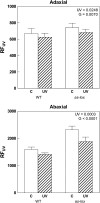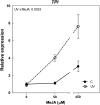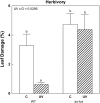Jasmonate-dependent and -independent pathways mediate specific effects of solar ultraviolet B radiation on leaf phenolics and antiherbivore defense
- PMID: 20007446
- PMCID: PMC2815854
- DOI: 10.1104/pp.109.148999
Jasmonate-dependent and -independent pathways mediate specific effects of solar ultraviolet B radiation on leaf phenolics and antiherbivore defense
Abstract
Ultraviolet B (UV-B) radiation, a very small fraction of the daylight spectrum, elicits changes in plant secondary metabolism that have large effects on plant-insect interactions. The signal transduction pathways that mediate these specific effects of solar UV-B are not known. We examined the role of jasmonate signaling by measuring responses to UV-B in wild-type and transgenic jasmonate-deficient Nicotiana attenuata plants in which a lipoxygenase gene (NaLOX3) was silenced (as-lox). In wild-type plants, UV-B failed to elicit the accumulation of jasmonic acid (JA) or the bioactive JA-isoleucine conjugate but amplified the response of jasmonate-inducible genes, such as trypsin proteinase inhibitor (TPI), to wounding and methyl jasmonate, and increased the accumulation of several phenylpropanoid derivatives. Some of these phenolic responses (accumulation of caffeoyl-polyamine conjugates) were completely lacking in as-lox plants, whereas others (accumulation of rutin and chlorogenic acid) were similar in both genotypes. In open field conditions, as-lox plants received more insect damage than wild-type plants, as expected, but the dramatic increase in resistance to herbivory elicited by UV-B exposure, which was highly significant in wild-type plants, did not occur in as-lox plants. We conclude that solar UV-B (1) uses jasmonate-dependent and -independent pathways in the elicitation of phenolic compounds, and (2) increases sensitivity to jasmonates, leading to enhanced expression of wound-response genes (TPI). The lack of UV-B-induced antiherbivore protection in as-lox plants suggests that jasmonate signaling plays a central role in the mechanisms by which solar UV-B increases resistance to insect herbivores in the field.
Figures








References
-
- A-H-Mackerness S, Surplus SL, Blake P, John CF, Buchanan-Wollaston V, Jordan BR, Thomas B (1999) Ultraviolet-B-induced stress and changes in gene expression in Arabidopsis thaliana: role of signalling pathways controlled by jasmonic acid, ethylene and reactive oxygen species. Plant Cell Environ 22 1413–1423
-
- Andrade A, Vigliocco A, Alemano S, Miersch O, Botella MA, Abdala G (2005) Endogenous jasmonates and octadecanoids in hypersensitive tomato mutants during germination and seedling development in response to abiotic stress. Seed Sci Res 15 309–318
-
- Ballaré CL (2009) Illuminated behaviour: phytochrome as a key regulator of light foraging and plant anti-herbivore defence. Plant Cell Environ 32 713–725 - PubMed
-
- Ballaré CL, Barnes PW, Flint SD (1995) Inhibition of hypocotyl elongation by ultraviolet-B radiation in de-etiolating tomato seedlings. 2. Time-course, comparison with flavonoid responses and adaptive significance. Physiol Plant 93 593–601
Publication types
MeSH terms
Substances
LinkOut - more resources
Full Text Sources
Miscellaneous

